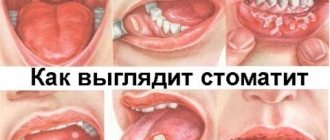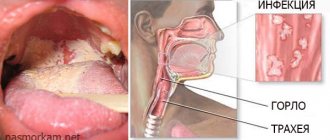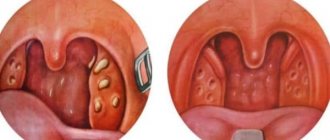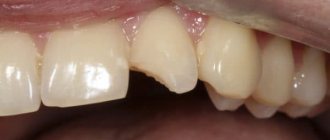Any person has experienced situations when he experienced discomfort in his throat. They can manifest themselves in different ways.
In other cases, inflammation of the surface of the tonsils immediately occurs.
Usually the pain intensifies when swallowing, and sometimes it becomes difficult for a person to speak. These warning signs cannot be ignored.
They may indicate the onset of a serious illness.
Pain can be a sign of more than just a cold. It may indicate that bacteria or viruses have entered the body.
Of course, any pathology should be treated in a timely manner. The treatment method will depend on the diagnosis.
A discomfort in the throat may appear as a result of:
Viral infection
. The onset of the disease is usually associated with a sharp increase in temperature. A runny nose may be present. Sometimes the mucous membrane of the eyes becomes inflamed.
A person constantly feels dry in the mouth. The pain increases during swallowing. It can get into your ears.
It is necessary to start treatment as early as possible to prevent complications.
If allergic reactions occur
The mucous membranes of the nose and oral cavity may become inflamed.
Swallowing may cause pain. An allergic attack can result in very dangerous consequences.
If the first signs of an allergy occur, you should immediately seek help from a medical specialist.
The occurrence of tonsillitis
, is almost always accompanied by an uncomfortable throat condition.
The most characteristic symptoms are: inflamed and enlarged tonsils, increased salivation, a tickling sensation, pain when swallowing.
Foreign body entry
. If a person accidentally swallows a foreign object (a piece of solid food, a bone, etc.), the mucous surface of the throat becomes irritated.
In such a situation, the patient will feel increased pain.
For colds
Cough, fever and runny nose often appear. Sore throat in these cases can be relieved with local antiseptic drugs.
In what cases should you not treat yourself?
When answering the question of what to do if your throat hurts very badly, you should consider situations in which self-treatment is unacceptable.
If the fight against a bacterial or viral infection is not started in time, it can lead to dangerous complications.
If germs enter the lungs, pneumonia can occur. The entry of harmful microorganisms into the brain will provoke the occurrence of meningitis.
Penetration of infection into the kidneys leads to the development of pyelonephritis.
But, unfortunately, people often do not take the appearance of pain in the throat seriously and try to start self-treatment.
In this video you can learn more about the topic of the article:
There are situations in which you should definitely consult a doctor:
- The patient loses a lot of weight;
- Reddish rashes appear on the skin;
- Your head starts to feel dizzy;
- The lymph nodes are significantly enlarged;
- The pulse quickens, it becomes difficult to breathe;
- Blood appears in saliva;
- The sore throat does not go away within a week.
Women during pregnancy should definitely consult a doctor if they experience a sore throat.
Signs of a sore throat
Acute infectious pathology is caused by bacteria - streptococci, staphylococci, and sometimes other microorganisms. Severe intoxication and inflammation of the tonsils are classic signs that accompany tonsillitis. A severe sore throat, hyperthermia, weakness, and weakness are the most common complaints of such patients. Discomfort in the joints and lower back may occur. Often a headache occurs with a sore throat. A person experiences a feeling of dry mouth.
At the same time, many patients feel how much their throat and ear hurt. Unfortunately, in this case we are talking about the spread of a pathological process in the body. Self-medication is completely unacceptable here, since the infectious-inflammatory process can also affect the brain.
Healing procedures
What to do if your throat hurts very badly? First of all, you should listen to the advice of doctors
Motor and mental activity should be kept to a minimum. The body will need a lot of strength to fight the disease.
If there is a bacterial or viral infection in the body, only local symptomatic drugs cannot be used for treatment.
To influence the causative agent of the disease, it is necessary to use antiviral or antibacterial agents.
You must stop smoking and drinking alcoholic beverages, at least for the duration of your illness.
It is necessary to gargle as often as possible. For this purpose, medications or decoctions of medicinal herbs are used.
Rinsing procedures will soften the surface of the mucous membrane and help eliminate germs.
If severe pain is present, it can be relieved with painkillers.
Here's more information in the video:
You should wrap a warm scarf around your neck. The throat should be warm. The air in the room should be humidified.
Gargling for sore throat
Gargling is considered the best method for treating a sore throat. The more often the procedure is performed, the faster the mucous membrane of the throat will recover. To do this, you can use pharmaceutical products:
- Furacilin.
- Chlorhexidine.
- Miramistin.
- Rotokan.
- Chlorophyllipt.
Medicines are mixed with warm water. If you don’t have them on hand, you can make medicinal solutions yourself. The most budget-friendly and affordable option is the use of sea or table salt. Add 1 tsp to a glass of water. ingredient. For effectiveness, add a few drops of iodine to the solution.
Medicinal herbs - chamomile, sage, oak bark - have an anti-inflammatory effect. Add 1 tbsp to 200 ml of hot water. l. any herb. Let it brew for 20-30 minutes. During this time, the infusion has time to cool to the optimal temperature. Strain. Rinse your throat.
To quickly achieve a positive effect, you need to gargle at least 6-8 times a day. In this case, the duration of one procedure is at least 5 minutes. In the first days, manipulations are carried out every hour.
Treatment of the disease
The following treatment procedures are usually used:
- Antiseptic drugs are used to irrigate the throat. Sucking lozenges have a good effect. Treatment can be carried out using medications: Furacilin, Miramistin or Dioxidin;
- Inhalations can be carried out using cedar or eucalyptus oil. They reduce pain and relieve inflammation;
- Antibiotics should be used only if a bacterial infection is added to the underlying disease. Treatment of tonsils can be carried out using Bioparox or other similar drugs;
- The use of complex medicines is resorted to only if there is pronounced intoxication - high fever, severe pain when swallowing, general malaise, aching joints. You can alleviate the patient's condition with the help of Coldrex or Maxgripp.
The site is a medical portal for online consultations of pediatric and adult doctors of all specialties. You can on the topic “sore throat hurts to swallow and speak”
and get a free online doctor’s consultation.
Ask your question
Diagnostics
An otolaryngologist is involved in finding out the cause that caused the sore throat. A diagnostic search involves a comprehensive examination of the oral cavity and respiratory tract using instrumental and laboratory methods; in the presence of concomitant symptoms, visualization of the thoracic and abdominal organs is performed. The following methods are considered the most informative for diagnosing acute sore throat:
- Instrumental inspection
. For a detailed study of the condition of the respiratory system, pharyngoscopy and indirect laryngoscopy are effective. To exclude an otogenic cause of sore throat, otoscopy is performed. During the study, the appearance of the mucous membranes, the presence of plaque and areas of ulceration are assessed. - Bacteriological analysis
. For bacterial culture, a throat swab, sputum or plaque samples are taken. The method is necessary to confirm the most common diseases accompanied by a sharp sore throat - sore throat, viral or bacterial pharyngitis. Express diagnostics includes RIF of pharyngeal swabs. - Sonography
. For acute pain in the neck and throat that persists for a long time, an ultrasound examination is necessary to exclude pathology of adjacent organs. The method makes it possible to identify local accumulations of pus in the peripharyngeal tissue, the presence of cysts and space-occupying formations. An ultrasound of the thyroid gland is also required. - X-ray examination
. If there is severe pain in the neck and throat, an x-ray of the larynx is indicated to exclude a tumor process. For detailed visualization, a CT scan of the larynx is recommended. In some cases, a radioisotope scan of the thyroid gland is performed. - Laboratory research
. Patients who feel a sore throat are prescribed a standard clinical and biochemical blood test, and the fasting glucose concentration is measured. To exclude chronic diseases, liver tests are performed according to indications, acute-phase indicators and the level of certain enzymes are determined.
To identify endocrine pathology as the leading cause of pain, a blood test for thyroid and adrenal hormones is necessary. Serological reactions (RIF, ELISA, PCR) are needed to identify pathogenic microorganisms. Additionally, X-rays and CT scans of the cervical spine can be done. In the presence of dyspeptic disorders, FGDS and intraesophageal pH-metry are used. Patients who have a sore throat should be examined by a dentist for the presence of inflammatory processes in the teeth and periodontium.
Throat examination
Questions and answers on: sore throat hurts to swallow and speak
2014-03-23 20:31:29
Nina asks:
Hello! help me please! I’m 24 weeks pregnant, my throat hurts terribly, it hurts to swallow, and when I read aloud it hurts my ear, there is no fever, runny nose, or cough. I went to the ENT specialist, she said it was an exacerbation of chronic tonsillitis. She prescribed Bioparox, Lysobact and rinsing with chlorophyllipt. I did all this for a week, it didn’t help, it only made it worse. I took a culture from the throat, with sensitivity to antibiotics, they revealed a culture of Aeromonas salmonicida 10 to 5, I went to the doctor, she shrugged her shoulders.. You can’t take antibiotics, but you still suffer from a sore throat.. what should I do? What kind of infection do I have? Thanks in advance for your answer!
Yuri Alexandrovich Sukhov answers:
Good afternoon. Nina, according to your description, you have a clinical exacerbation of chronic tonsillitis plus otitis and, possibly, sinusitis. You need to contact a good ENT doctor and be treated by him. Best regards, Yu. Sukhov
2013-06-05 10:16:33
Alena G asks:
Good afternoon, dear doctor!! I really ask for advice, the situation is old with a long history, but unfortunately it remains without resolution! Summary: back in the fall of 2012, l/s under the armpits and on the neck increased (all not very large up to 2 cm ), I had a slight cold - a red throat, it hurt to swallow, they first prescribed various gargles, sprays did not help, in the end I drank Augmentin - the throat went away, but the state of terrible weakness, no powerlessness ((the temperature began to rise to 37.2, the process of walking began doctors, tested for all kinds of viruses and infections, only EB, CMV and HSV were detected - in latent form (i.e. G is present, but M is not), ultrasound of the abdominal cavity was normal, urine was normal, blood was normal at first, but a month later 3 of all this, there is an increase in lymphocytes (up to 60) + a decrease in leukocytes 3 (due to segmented), I went to the hematologist - she looked at everything, felt the bone marrow, took a bone marrow puncture - and so EBarr is sitting there! It is written - During an immunohistochemical study, all the existing nuclear-containing elements EBV are positive! They also did immunophenotyping of lymphocytes (as I was told in the laboratory, the immunogram indicators were also included), there, in conclusion, in the examined blood sample, the content of Ti B cells was shifted due to a decrease in the B cell population_Helper-suppressor ratio 2.13, which corresponds to the norm, NK cells 16.8% (normal) The level of proliferative activity is normal! I also have aching bones, like the flu, mainly in the upper shoulder belt, arms and shoulders! I went to a rheumatologist - rheumatology tests were normal! At first all the doctors said that everyone has these herpes viruses - and that it’s none of their business, but since they didn’t find anything else, they really prescribed me therapy - Valtrex 500 2 rubles a day + cycloferon and lycopid every other day for 2 weeks! The doctor thus has a question - what can my blood, immunogram and symptoms say? I’m really asking for advice - I’ve been suffering for a long time ((About myself - 25 years old, female, a child who was often sick in childhood, but before this situation, in principle, I wasn’t often sick! I’m waiting for an answer, thank you for your attention! I’m writing to you for the second time, because maybe I’ll have some problems any suggestions about me - I would be glad to hear any thoughts!! Could it be something autoimmune? Thank you for your attention
2013-05-28 09:59:10
Alena G asks:
Good afternoon, dear doctor!! I really ask for advice, the situation is old with a long history, but unfortunately it remains without resolution! Summary: back in the fall of 2012, the l/s under the armpits and on the neck increased (all not very large, up to 2 cm ), I had a slight cold - a red throat, it hurt to swallow, they first prescribed various gargles, sprays did not help, in the end I drank Augmentin - the throat went away, but the state of terrible weakness, no powerlessness ((the temperature began to rise to 37.2, the process of walking began doctors, tested for all kinds of viruses and infections, only EB, CMV and HSV were detected - in latent form (i.e. G is present, but M is not), ultrasound of the abdominal cavity was normal, urine was normal, blood was normal at first, but a month later 3 of all this, there is an increase in lymphocytes (up to 60) + a decrease in leukocytes 3 (due to segmented), I went to the hematologist - she looked at everything, felt the bone marrow, took a bone marrow puncture - and so EBarr is sitting there! It is written - During an immunohistochemical study, all the existing nuclear-containing elements EBV are positive! They also did immunophenotyping of lymphocytes (as I was told in the laboratory, the immunogram indicators were also included), there, in conclusion, in the examined blood sample, the content of Ti B cells was shifted due to a decrease in the B cell population_Helper-suppressor ratio 2.13, which corresponds to the norm, NK cells 16.8% (normal) The level of proliferative activity is normal! I also have aching bones, like the flu, mainly in the upper shoulder belt, arms and shoulders! I went to a rheumatologist - rheumatology tests were normal! At first all the doctors said that everyone has these herpes viruses - and that it’s none of their business, but since they didn’t find anything else, they really prescribed me therapy - Valtrex 500 2 rubles a day + cycloferon and lycopid every other day for 2 weeks! The doctor thus has a question - what can my blood, immunogram and symptoms say? I’m really asking for advice - I’ve been suffering for a long time ((About myself - 25 years old, female, a child who was often sick in childhood, but before this situation, in principle, I wasn’t often sick! I’m waiting for an answer, thanks for your attention
2014-10-19 10:41:16
Alexander asks:
My throat hurts, it hurts to swallow, and when I speak everything inside shrinks and I speak in a different voice
Answers:
Hello! The most likely diagnosis is acute laryngitis (inflammation of the larynx). However, other options are possible, including damage to other organs located in the neck. In order to make an accurate diagnosis and be able to discuss the necessary treatment, it is necessary to conduct an examination and examination. We advise you to have an in-person appointment with an ENT doctor. Take care of your health!
2014-06-01 15:05:03
Oksana asks:
Hello! I have chronic tonsillitis. 2 months ago I had my tonsils cleared, but the pain on one side did not go away, it hurts to swallow, I went to the doctors again, they said that everything is fine with me, see a neurologist, I was treated by a neurologist, my throat still hurts, especially on the left. the lymph nodes began to enlarge, could it be from tonsillitis, my tonsils are always hypertrophied and my throat is still red. I recently went to the doctor, she asked me why I haven’t removed my tonsils yet, but no one advised me. She said , that it was advisable to delete it before the age of 40, and I’m 41, is it really too late?
Molotov Alexander Viktorovich answers:
Good afternoon. Removal of tonsils (AMPUTATION) is carried out strictly according to indications and in rare cases. Now there are many methods and methods of treatment. Complex 2-3-fold method of treatment of Chronic tonsillitis (herbal therapy, homeopathic treatment, local, cryotherapy, etc.) - effectiveness 75-80%. We provide this treatment at the MC. www.otolaryngology.kiev.ua Get well and then start hardening. ENT doctor MOLOTOV A.V. .
2013-02-24 12:38:24
Julia asks:
Good afternoon. On February 15, 2013, I had unplanned protected sex, after which I developed a kind of sore throat. My throat hurt terribly, it was painful to even swallow saliva, my temperature rose to 38.2, my chest hurt sharply, I felt sick and dizzy, not to mention loss of appetite, and there was phlegm. To put it bluntly, sex was more like rape. It was the first time I had sex in my life, but I was no longer a virgin. Through negligence, at the age of 11, I tore my fingers there and have since gotten used to it, of course, but I’m not at all proud of it. At the moment I am 16 full years old. I got over this sore throat. I was afraid that I had caught syphilitic from this guy. But now everything seems to be fine. The only thing that bothers me is pain in the stomach when eating, sharp tingling in the area of the liver, spleen and heart (i.e. on the right and left sides) and my chest hurts like hell. This never happened before, only sometimes my bile hurt, because I have had problems with it since childhood. Well, there is also a green coating on the tongue, but this is most likely due to antibiotics, it probably doesn’t matter. I didn’t go to the gynecologist because she was busy, about the chest pain - I thought it would go away in a week... But it didn’t. My breasts have even increased by half a size (currently a size three and a half) and this became noticeable immediately. When I walk around at home without a bra and my nipples touch everything, it hurts to move at all. I don’t know what to do, I’m still afraid that I could have contracted syphilis through disgrace. My friends reassure me that everything will be okay, but it’s not that I’m scared... I’m just somehow disgusted with myself. Thanks in advance.
Answered by the Medical Consultant of the website portal:
Contact a gynecologist, mammologist and gastroenterologist at your place of residence, get tested and live in peace or get treatment, depending on their results. Despite how busy you are, the doctors will definitely see you and give you directions for all the tests. Good luck to you.
2013-02-04 06:16:57
Irina asks:
Hello. Please tell me. I have had a sore throat at the base of my neck for two and a half months now. At first they said - tonsillitis, then - a reaction to the eruption of the 8th teeth, they were removed, but it hurts again. The ENT specialist and the therapist unanimously say it’s not tonsillitis: the throat is not red, the tonsils are fine. Yes, I myself feel that it’s not a sore throat, because it doesn’t hurt me to swallow. But when you inhale, your throat “scratches” at the base of your neck. In the morning I notice gray sputum, but not from the lungs, but as if from the throat; during the day it is not there. When coughing up phlegm, the throat at the base of the neck hurts even more. Additionally: The therapist listened to the breathing and said it was hard. Chronic bronchitis persists. Maybe this somehow affects the throat... I also have problems with the intestines and gall bladder - the ENT said I need to do an FGDS - sometimes the vagus nerve of the esophagus radiates into the throat. I am also seeing a neurologist for osteochondrosis of the cervical spine, VSD and astheno-neurotic syndrome. I am receiving vascular treatment for the head (thiocetam). Please tell me where to start and what examination to undergo? I'm already starting to be afraid of these unpleasant sensations in my throat! Thank you!!!
2013-01-02 16:30:11
Oleg Ivanovich asks:
Hello, Doctor. Since October 4, 2012, I have had a sore throat on the right side for 3 months. And what is typical, usually the throat hurts for 2-3 days and comes out with either a runny nose or a cough for 4-5 days. And that’s it – I’m healthy! And then there’s something incomprehensible, like a painful lump on the right side of the pharynx near the Adam’s apple. It hurts to swallow. I gargled with salt water and soda, made an alcohol compress - to no avail. In November I consulted an ENT doctor. The doctor prescribed Yox spray, I rinse the antibiotic with Calendula tincture and drink the antibiotic Clarbact, Fromilin uno. Although the ENT doctor did not find a sore throat. In December I had an ultrasound of my throat - everything was normal. In mid-December I did an FGS of the stomach - the norm. Even through the nose, the doctor climbed into the throat with a small stereoscope with a light bulb until the bronchi themselves examined everything. Didn't find anything. Some doctors advise strengthening the immune system by drinking dietary supplements Desyatisil, Zhivitsa. I drank dietary supplements for a month (consisting of -10 natural ingredients. Mumiyo, badger fat, chaga, deer antlers, milk thistle, propolis and honey). Other doctors say that the inflammation is due to a disease of some other organ. They referred me to a neurologist. He found that the 5th cervical vertebra was painful (I actually have osteochondrosis with experience). He says the pain radiates to the throat (?) He prescribed a bunch of medications, nicotine, sedatives - he injected it, drank pills, warmed it up. I massaged, but the pain in the spine intensified in the cervical region. (As if he had picked out a sore). At the end of December, after drinking everything recommended, I felt that now the pain in my throat when swallowing began to radiate (radiate) to the right side of the sternum (somewhere 3-5 cm below the right collarbone). Then the pain became constant on the right side of the sternum. It’s as if something hurts and aches, and there’s a lump in the sternum just below the collarbone below between the 1st and 2nd thoracic ribs. And the pain in the throat is worse in the morning, but it goes away a little when swallowing, especially when you turn your head to the left or drink tea while swallowing. There is something lump under the collarbone, drying and aching. Temperature 36.0 - 36.2. Blood pressure 135 over 90. All blood and urine tests are normal! Combat officer. From Afghanistan I have an ulcer of 12 P.K. She is now in remission.” My pancreas has been bothering me for 2 years; my kidneys and stomach used to hurt (from time to time). I haven’t drunk for 3 years (only a little beer), I haven’t smoked for 25 years. The character is asthenic, he even became somewhat suspicious. (Apparently age is taking its toll, these sores and nervous work as a security chief, I’m 55 years old). Tell me what other doctors to see, or medications, what to inject, what tests to take? Regards, Oleg.
A sore throat, like any other pathological process in the body, brings discomfort to our lives. As usual, we suffer from difficulty swallowing and breathing, general weakness, fever, and cough. Often these symptoms are accompanied by painful discomfort during conversation, hoarseness of the voice or its absence at all. In medical practice, there are also cases when a sore throat is not accompanied by classic and ARVI, but pain when talking makes itself felt. Experts today suggest that you familiarize yourself with the possible causes of pain during a conversation and the answers to the question “What to do if it hurts to speak?”
Treatment approach: how to remove
You should know! The most effective treatment is medication.
It not only fights the problem from the inside, but also significantly alleviates the patient’s condition.
This type of treatment is almost always started, regardless of the cause of dry throat. The only difference is in the approach to certain medications.
The doctor prescribes the following medications:
- Nasal drops . These can be purchased saline solutions or self-made drops based on sea salt. The number of instillations is determined by the therapist or other attending physician.
- Throat soothing lozenges or tablets. The selection of these funds depends on the specific case. The more severely the larynx dries out, the more effective remedies should be purchased.
- Humidifying the air in the room. In this case, the patient should be excluded from allergic manifestations to a particular aroma.
Important! Medications are not prescribed for diseases such as thyroid disease, salivary gland diseases and ENT diseases.
Folk remedies
Traditional recipes help almost all patients, as they cope with the problem effectively and without consequences for the body.
Traditional medicine methods are also used for pain in the larynx.
Effective and efficient include:
- Warm drinks in the form of herbal teas, warm fruit drinks, freshly squeezed juices. Adding honey to tea enhances the effect. The mucous membrane softens well and the dry effect disappears.
- Gargling with vinegar solution. To prepare it, take a tablespoon of vinegar and dilute it in a glass of warm water. After this, gargle for minutes for several days until you feel a noticeable improvement.
- Carrot-honey juice. Fresh honey is melted and carrot juice is squeezed out in a 1:1 ratio. Drink in small sips, warm, half a glass 3-4 times a day.
- Cabbage squeeze in the form of juice. This remedy requires dosage as it has a strong fermentation effect. You should drink no more than two glasses a day. And drink in small portions, preferably teaspoons.
- Blackcurrant in any form. This can be fresh juice, frozen berries added to herbal tea or fresh currants.
If the cause of dryness in the larynx is dry air in the room, then in addition to lozenges you need to purchase an air ionizer.
Reference! If you have problems breathing through your mouth, you should swallow a couple of spoons of vegetable oil before going to bed.
The oil will soften the mucous membranes of the mouth and nasopharynx and allow smooth breathing to accompany your sleep.
For ARVI and other respiratory diseases, the nasopharynx should be rinsed with soda solution. This will help avoid discomfort and aid in recovery.
Throat pathologies as causes of pain during conversation
Why does it hurt to talk? The answer to this question is key information for making a diagnosis and developing effective treatment for sore throat. The classic cause of sore throat and pain during vocal strain is the common cold, which has a well-known symptom complex and is easily diagnosed by medical specialists. In this case, there is no reason to panic, because even standard home treatment will quickly bring you back to normal and relieve a sore throat. If it becomes painful to speak, you constantly want to sleep, but you simply don’t have the strength, then the activity of pathogenic organisms is taking place here. The viral infection, having passed through the protective barriers of the nasal membranes, settles in the throat and causes painful discomfort. It is these two pathologies that are the most common causes of pain in the throat and, accordingly, pain when speaking.
In the absence of standard symptoms of viral and colds, the following pathologies may be the causes of a situation where it is painful to speak:
- Laryngitis
is an inflammation of the mucous membrane of the larynx. As a result of swelling of the throat, patients feel a certain numbness and stiffness, and after a few hours the voice suffers - it becomes hoarse, “tired” or even barely audible. A distinctive feature of laryngitis in adult patients is the absence of elevated temperature, despite the rapid development of the inflammatory process in the throat. If it is painful for a child to speak, and the symptoms indicate laryngitis, then the elevated temperature should not confuse the doctor, because the child’s body is more susceptible to viruses and bacteria, which is why the temperature jump occurs. If a medical professional has diagnosed laryngitis, then along with standard procedures (drinking plenty of warm drinks, taking antiviral medications, in severe cases, antibiotics, warm compresses), you should take care of your voice for several days - avoid talking even in a whisper; - Allergic irritation of the mucous membrane of the throat
also causes discomfort during conversation. This pathology can easily be confused with a common cold or viral infection, since the symptomatic picture is very similar: it hurts to speak and swallow, the temperature rises slightly, and it begins. But specific symptoms of allergic exposure are tearfulness and severe itching in the throat. An allergen that causes a sore throat can be plant pollen (especially in spring), tobacco smoke, dry and polluted air (especially important for urban areas), food products, alcohol, mold, fabrics and much more. If you have an allergic reaction, antibacterial throat sprays, vasoconstrictor nasal drops, and antiviral teas will not help you. Rinsing the nasopharynx with saline solution, humidifying the air and, of course, eliminating the allergen will help alleviate your condition and restore the ability to speak normally; - “Voice failure” or overstrain of the muscles of the larynx
deprives us of the ability to speak normally. Due to the increased tone of the larynx, the throat hurts, it hurts to speak, but overall health remains normal. It is quite simple to distinguish “voice breakdown” from other pathologies, especially if on the eve of a painful conversation you had to speak for a long time and loudly. Your doctor will definitely tell you about specific treatment for laryngeal strain, but vocal rest will help alleviate the condition; - A throat injury
(bruise, burn, etc.) causes pain and, of course, affects the ability to speak. If, as a result of mechanical, thermal or other effects on the nasopharynx and oral cavity, you feel pain and discomfort, consult a doctor immediately; - Malignant neoplasms
in the nasopharynx and oral cavity, first of all, provoke difficulty breathing, and as the disease progresses, it becomes painful to speak and swallow. The patient's voice becomes hoarse and "tired". People who abuse alcohol and smoke are most susceptible to this pathology.
Separately, HIV should be noted as a cause of sore throat and a condition where it hurts to speak. The body of an HIV-infected person is weakened and highly susceptible to the influence, and soreness in the throat can also be associated with the influence of a secondary infection (cytomegalovirus, stomatitis).
Folk remedies for loss of voice
Severe sore throat with loss of voice can be cured using traditional methods. The most effective and safest remedy is the use of bee products in the form of honey and propolis. They contain a large number of amino acids, vitamins and minerals. They also have an immunostimulating and anti-inflammatory effect.
There are several good recipes:
- Every time before going to bed, you can eat a spoonful of honey. It envelops the mucous membrane and prevents it from drying out.
- Take milk with propolis. This remedy helps both with severe sore throat and with various types of cough. Add 5 g of bee glue to a glass of warm milk. Use the medicine 4-6 times a day.
- There is another effective remedy that helps with hoarseness and loss of voice. To prepare it you will need 200 ml. milk, 1 tsp. soda, 50 ml mineral water. Milk is heated to a temperature of 37-38 degrees. Add mineral water and then soda. Take the prepared composition 3 times a day.
- A sore throat bothers you at any time of the day. Therefore, in order to relax, gain strength and soothe the mucous membrane of the throat, it is recommended to use a medicine made from warm milk, a piece of butter and a spoon of honey.
For severe sore throat, doctors advise lubricating the mucous membrane with sea buckthorn oil, aloe juice, peach oil with the addition of menthol and vitamin A.
Steam inhalations are often used in treatment. Then add a few drops of pine, cypress, lime, eucalyptus or fir ether to the hot water. The procedure is carried out twice a day.
Folk remedies help to quickly cope with unpleasant symptoms. But before using them, it is necessary to exclude the presence of allergic reactions.
Throat hurts without fever
Many believe that if the thermometer does not show a high temperature, but it hurts to speak and swallow, then there is no disease. But this is a wrong opinion. There are a significant number of ailments where there are no symptoms of illness other than discomfort in the throat. For example, allergies.
This disease can manifest itself as follows: a person feels the presence of a lump in the throat that interferes with breathing and even speaking. Other symptoms characteristic of this disease are also observed: skin rash and itching. To determine the substance that caused the allergic condition, it is necessary to visit a specialist.
Sometimes a person does not even suspect that he is allergic, since he has never experienced an allergy reaction. But allergens accumulate in the blood gradually, over a certain period of time. And when the immune system weakens, they begin to act.
The professional activity of the sick person can also be cited as a reason for the development of a throat disease. Teachers, singers, announcers and anyone who needs to talk or sing a lot often are at risk of getting laryngitis or pharyngitis. Gastrointestinal diseases can contribute to the development of throat diseases. High stomach acid sometimes causes acid to back up into the upper esophagus. Reaching the throat, it irritates the mucous membrane. As a result, tickling, coughing and pain begin. Poor ecology, excess gases in the environment, frequent smoking or being in a room with tobacco smoke can lead to drying out of the mucous membrane. And this leads to the development of sore throat, laryngitis or pharyngitis.
If a person complains that it hurts only on the right side or on the left, then most likely a foreign object has entered the throat. This happens when children play, when eating with food, when sneezing and in other ways. Having penetrated the larynx, the foreign body damages the mucous membrane. Swelling begins and the inflammatory process gradually develops. It hurts even to swallow saliva. Urgent medical assistance is needed. Otherwise, complications may develop: throat infection, ulcers, bedsores. A foreign object can block the breathing path, causing death. If the lack of air is only partial, then the person experiences difficulty swallowing. The body begins to defend itself by coughing and vomiting, trying to push the extra object out.
Return to contents
Why does the throat become inflamed? How to diagnose the cause and how to treat it?
Infectious agents that can settle on the mucous membranes of the oropharynx are multiple. In the vast majority of cases, the entry of such structures into the pharynx results in a sore throat.
Common infectious, viral and fungal agents include:
- Candida fungi. Most often found in younger patients. The “contingent” mostly does not reach 3 years. However, sometimes adults suffer too. Candida is dangerous due to possible damage to the lower respiratory tract due to its expansive spread. These fungal structures also destroy tissue. Complications from the cardiovascular and respiratory systems are possible.
- Staphylococci. Mostly golden. They provoke the most dangerous lesions of the oropharynx. The formation of an abscess and purulent tonsillitis is possible. Since bacteria multiply quickly and create large conglomerates, they are not easy to deal with. An integrated approach is required.
- Streptococci. They provoke complex forms of inflammation of the pharynx. Somewhat less dangerous than staphylococci. However, they are able to influence the composition of the blood (that is why they are called hemolytic streptococci). Sluggish forms of the disease are the most common type of streptococcal infection.
- Atypical representatives of the flora. These are mycoplasmas, ureaplasmas, chlamydia, gonococci. Also some other structures. They provoke indolent forms of inflammation of the throat. They are extremely rare, since their penetration into the pharynx using classical methods is almost impossible.
- Herpes viruses. Especially often we are talking about agents (strains) from the first to the fifth type. Particularly dangerous are subtypes four (Epstein-Barr virus) and five (cytomegalovirus).
- Human papillomaviruses.
- Rotaviruses and adenoviruses.
- Airborne path. The first and foremost among all. It is especially common when breathing through the mouth. Pathogenic structures feel at ease on the mucous membranes of the oral cavity. Even a few minutes of being in the same room with an infected person is enough.
- Contact and household. When using personal belongings of an infected person, during physical interactions of a non-sexual nature.
- Oral-genital. It is in this way that atypical agents penetrate the oral cavity.
It is possible for microorganisms to move up (ascending path) and down (descending path).
From the lower lungs or nasopharynx, respectively.
We suggest you read: Drooling in a dream as an adult
Also, viruses, fungi, and bacteria move throughout the body with the flow of blood and lymph. Less commonly, other methods of transportation are possible. The main ones are described.
In this case, the term “immunodeficiency” should be considered in a broad sense. That is, like any decrease in the intensity of the protective forces. This includes a virus of the same type that causes HIV.
Bacteria, protozoa and fungi are present in the body of every person, but not everyone gets sick.
Why is this happening? The reason lies precisely in the weakening of the immune system.
In what cases is there a significant decrease in the intensity of the protective forces:
- Incorrect and irrational use of antibacterial drugs. It affects the state of immunity in the most negative way, causing a persistent decrease in it up to critical levels. Thus, you should not abuse antibiotics; they are used only when indicated.
- Taking birth control pills. Oral contraceptives cause an artificial increase in estrogen in the blood of the fairer sex. This affects the state of the immune system.
- Frequent acute respiratory infections and other diseases of bacterial, fungal, viral origin.
- Hypothermia.
- Alcohol abuse.
If you have a sore throat, infectious factors are often viral, while bacterial ones are a consequence of incorrect treatment or lack thereof.
Among the diseases are:
- Tonsillitis of bacterial, viral, fungal origin. It occurs most often and has a common name - sore throat. It is provoked by the already mentioned pathogenic agents. With tonsillitis, the back wall of the throat and tonsils are inflamed on both or one side.
- Pharyngitis. Damage to the oropharynx of an infectious or other nature (less often allergic, chemical, traumatic). Causes breathing problems.
- Pharyngomycosis. Fungal infection of the velopharyngeal arch. It is a type of pharyngitis.
- Throat abscess. Causes significant discomfort and inflammation of the oropharynx in the affected area. Artificial obstruction (narrowing) of the airways is possible.
- Nonspecific diseases, such as bronchitis, pneumonia, which develop expansively and involve the oropharynx in the pathological process (this is rare).
- Tracheitis and laryngitis.
Patients encounter them much less often. However, similar factors also occur in some cases.
Among the most common:
- Tobacco smoking. Abuse of tobacco products leads to chronic thermal burns of the mucous membranes of the throat and oral cavity. The result is the formation of permanent inflammation.
- Alcohol abuse. As already mentioned, it reduces immunity, but this is not the only effect of alcohol. The formation of chemical burns of the mucous membranes affects.
- Inhalation of chemical vapors. We are talking about working in hazardous enterprises in most cases.
If your throat hurts and your temperature rises
The throat may become sore with a simultaneous increase in body temperature. This usually happens when a virus or bacteria enters the human body. Harmful microorganisms are the cause of disease. Viral diseases such as influenza and ARVI begin with general malaise, high degrees on the thermometer, muscle pain and headaches. Gradually, the throat begins to become sore, and pain appears when swallowing. The disease can be mild, the person does not experience severe discomfort, his condition is at one stage and does not worsen. In this case, you can get by with treatment at home rather than in the hospital.
There are other illnesses caused by viruses. For example, measles or false croup. They can also cause a sore throat and painful swallowing. The temperature is also rising. But these manifestations of the disease are not the main ones and do not bother the patient as much as a debilitating cough (characteristic of croup) or a skin rash (the most indicative symptom of measles). These viral infections cannot be cured on your own. The sick person cannot avoid visiting the clinic so that possible complications do not develop in the future. The doctor prescribes a special treatment that will help quickly return your health to normal.
Bacteria cause diseases such as pharyngitis, bronchitis, and tonsillitis. The following microorganisms may be the culprits of these ailments:
- staphylococci;
- gonococci;
- streptococci;
- diphtheria bacillus;
- mycoplasma;
- chlamydia.
These diseases have a more severe course. The patient develops sputum with pus. The same purulent plaque appears on the tonsils. Gradually, pain begins to develop in internal organs: joints, heart, respiratory organs and others. Bacterial infections require mandatory medical care. The doctor prescribes antibacterial therapy and monitors the progress of the treatment process until the patient recovers completely.
Return to contents
Do I need to see a doctor?
When a severe sore throat occurs, not accompanied by any other symptoms, such as fever, drooling, the appearance of purulent formations on the back wall of the nasopharynx, then first you need to understand what it is and why the discomfort appeared.
The reason may be:
- an infection that has not spread throughout the body;
- an allergic reaction is possible;
- Great tension on the vocal cords the day before can also cause pain.
You can do without taking pharmaceutical medications, with the exception of relieving allergy symptoms. You just need to gargle more often and drink plenty of warm liquid.
For rinsing we use commonly available products:
- strong saline solution with a drop of iodine;
- baking soda dissolved in water;
- medicinal plants brewed in boiling water.
If the infection has not penetrated the bloodstream and has not spread, then the throat will stop hurting within two to three days, with regular gargling.
These tips apply exclusively to adults. In children, the body's protective processes are not yet fully formed and any untreated cold is fraught with serious complications.
If a child has a sore throat and he complains that it hurts to swallow and it hurts his ears, he should be shown to his local pediatrician. You should not wait for the disease to worsen or for the pain to go away on its own - the risk in this case is not justified.
In this case, folk remedies should be combined with medications prescribed by a doctor. Only a specialist can give recommendations on how to treat a sore throat at home.
You should treat pain in the throat completely differently when other threatening signs appear along with the pain. If severe swelling of the tissues, rashes on the skin, or even opening your mouth hurts, you should immediately contact a medical facility. This must be done regardless of whether there is a fever or no temperature.
What diseases cause inflammation of the throat?
Pathogens can enter the body in several ways:
- Through the air. Infectious diseases affecting the respiratory tract are often transmitted through airborne droplets. The increased risk is due to mouth breathing due to the lack of natural defense mechanisms. In this case, the mucous membrane is susceptible to pathogenic microorganisms that settle on its surface. The next stage is active reproduction. Some infections develop quickly. Infection can occur after a couple of minutes of interaction with an infected person.
- Oral route. Certain intracellular pathogens that inflame the throat enter the body in this way. Such microorganisms include chlamydia.
- Contact. You can become infected by touching personal belongings that belonged to the patient. The throat also becomes inflamed with physical contact.
//youtu.be/RTOopIukAuI
Diseases that provoke inflammation in the throat have similar symptoms:
- Fever.
- Sore throat.
- Painful sensations when moving, a feeling of aching.
- Attacks of dry cough.
- Apathy, decreased ability to work, poor health.
Once the inflammatory process affects the uvula and tonsils, the patient suffers unbearable pain when speaking, swallowing or coughing. There is a sharp deterioration in appetite. Often, against the background of inflammation, the lymph nodes in the larynx become enlarged.
The disease may be accompanied by a number of other diseases:
- Bronchitis.
- Sinusitis.
- Tuberculosis.
- Acute respiratory viral infection.
- Acute laryngitis.
- Scarlet fever.
- Flu.
- Measles.
- To get rid of swelling and redness. You can resort to rinsing procedures using medicinal herbs. A decoction can be made using sage, calendula or eucalyptus as plants that have effective anti-inflammatory as well as antibacterial effects. At home, if there are no herbs from the list, you can resort to a regular solution of water and soda. The patient needs to drink a lot. It is advisable to add lemon or raspberries to tea, and at night add honey to milk to soften your throat.
- If the patient has contracted a sore throat, the use of products like propolis and royal jelly will be effective. The medicine has an analgesic effect, suppresses pathogenic microflora, and restores tissue. It is necessary to chew propolis thoroughly and, an hour later, anoint the larynx with bee milk mixed with honey. They resort to medicine to soften the larynx.
- In case of pharyngitis, rinsing procedures will not be superfluous. Using beet juice has a quick and positive effect on the body. Peeled beets are rubbed, squeezing out the juice. After this, the mixture is poured with warm water. The solution is perfect for gargling about six times a day. It is better not to say a certain period of time after rinsing.
There are several recipes used for recovery. How to treat a sore throat:
- Yogurt, coffee, garlic and honey are mixed in a ratio of 3:2:1:10, after which corn flour is added so that the resulting sour cream takes on the desired consistency. The medicine is perfect for external use. Application of the product should be repeated several times a day with an interval of four hours. To achieve the desired effect, it is necessary to carry out the procedure for at least a week.
- Chopped garlic must be stuffed into walnut shells. The inner sides of the palms are treated with filling, when the shell is fixed using a breathable bandage. The procedure should be repeated regularly for the first five days. The use of the drug is justified at the onset of a sore throat. If the patient's condition is advanced, there is a decrease in effectiveness.
To cure your throat at home, you can use onion, lemon and garlic, as products that are considered an excellent remedy for fighting colds and viruses:
- You can drink a small spoon of onion juice every three to four hours.
- The lemon is cut into slices and chewed every couple of hours. The peel must be left. You must refrain from eating for an hour after the procedure.
- Diced onions are boiled in milk until they soften. Honey must be added to the resulting mixture. The medication should be taken once an hour with a tablespoon.
To carry out the procedure, you don’t have to limit yourself to a pharmaceutical drug. You can use regular garlic by chopping the product and pouring hot water over it. The mixture can be used for ten minutes by inhaling its vapors. One of the common home remedies is also boiled potatoes, used as an inhalant.
To prevent acute inflammation, as well as sore throat, it is necessary to constantly adhere to preventive measures and protect yourself from exposure to adverse environmental conditions. A few recommendations:
- Timely treatment of colds.
- Strengthening the immune system with vitamins.
- Proper nutrition.
- Regular walks in nature.
- The use of additional protective equipment during epidemics.
The acute form of the disease can cause the development of chronic inflammation. This condition of the patient will lead to the development of complications.
In the case of streptococcal pharyngitis, a peritonsillar abscess may form in the throat area. The symptoms of the disease are one-sided: the tissues are susceptible to swelling, the patient feels pain, and erythema occurs.
Pharyngitis can cause inflammation to spread to the larynx, bronchi or trachea. Prolonged treatment in some cases can cause the appearance of articular rheumatism.
//youtu.be/6JX8hUzivr4
A sore throat can occur due to a wide variety of reasons; let’s look at the most popular ones.
Infection – viral, bacterial, fungal. Sore throat in the vast majority of cases is one of the first signs of the onset of acute respiratory diseases (ARI). After all, the oropharynx is the body’s first protective barrier from external pathological factors. For example, the inhaled air may contain pathological infectious agents, which initially, due to the peculiarities of the functioning of the oropharynx, settle precisely on its mucous membranes (often on the tonsils).
Next, local immunity directs the necessary protective cells to the site of infection, which isolate viruses, bacteria and other microorganisms from getting inside. Outwardly, this is expressed in excess production of mucus, which envelops the infection, and further coughing or sneezing. With the help of coughing and sneezing, the body clears secretions that already contain infection.
We suggest you familiarize yourself with: How teeth impressions are made for braces and what photographs are needed for installation, how long it takes to make the system after the impression
The question may arise - why then does sore throat, pharyngitis, laryngitis, tracheitis, bronchitis, pneumonia appear (the diseases are listed in the order of progression of inflammation from the throat to the lungs)?
The answer is quite simple - in the development of these diseases, in addition to infection, secondary factors are also involved - weakening of local immunity, which may be due to hypothermia, stress, unreasonable use of certain medications, etc. In addition, viral infections (ARVI) are usually easier to tolerate than bacterial ones.
The most common infections that cause sore throat are viruses (influenza, parainfluenza, adenoviruses, rhinoviruses, reoviruses, respiratory syncytial virus (RSV), enteroviruses), bacteria (streptococci, staphylococci, pneumococci), fungi (candida).
Irritation of the mucous membranes of the throat - when a person inhales tobacco smoke, combustion products, fumes of various chemical compounds (based on chlorine, sulfur, phosphorus, etc.), paints and varnishes, glue, polluted air.
Eating cold foods – ice cream, lemonade, kvass, beer, dairy products, water. A particularly inflammatory process and further sore throat occurs if you eat or drink something cold quickly, or when a person gets hot in the summer sun.
A sore throat, depending on the underlying cause of the pathology, may be accompanied by various symptoms. Let's look at the most popular of them.
With a viral infection, there is a slow increase in sore throat, general malaise, headache, aching joints, increased fatigue and loss of strength, body temperature is normal or slightly elevated, runny nose, and the cervical lymph nodes may be enlarged.
With a bacterial infection, there is a rapid appearance and intensification of a sore throat (severe sore throat can appear literally within a day), redness of the throat, a sharp deterioration in general health, high body temperature, enlarged lymph nodes, nasal congestion, pain when swallowing, may increase in the size of the tonsil.
If the throat is irritated, the temperature does not change, a sore throat is felt, and there may be coughing and sneezing. In case of allergies, a runny nose, conjunctivitis, and itching may also be present.
- Inflammation of the throat is a lesion of the organs of the upper and initial parts of the lower respiratory tract (primarily the larynx).
- According to profile statistics (for European countries), the development of a pathological process of an inflammatory nature occurs in every second person in the population, if not to say that everyone has encountered a similar problem at least once in their life.
- There are a lot of options and factors for the development of the condition: from infectious diseases, such as tonsillitis, to other reasons, even banal smoking.
- We can talk about two categories of factors in the development of the disease process.
- As medical practice shows, in most cases we are talking about infectious causes and less often about factors of non-infectious genesis.
The causes of sore throat are infectious and non-infectious. Moreover, the first group is much more common than the second.
There are a huge number of pathogenic microbes that can settle on the mucous membranes of the oropharynx.
Most often, their entry there causes inflammation of the mucous membrane. The causative agents of the disease can be:
• Candida fungi usually occur in children under three years of age.
But in some cases they occur in adults. The danger of these pathogens lies in the likelihood of damage to the respiratory system due to too rapid spread. These fungi can destroy tissue. There may be complications from the heart and respiratory system;
• Staphylococci are most often aureus.
Causes the most serious lesions of the pharynx. An abscess and purulent tonsillitis may appear. Due to the rapid proliferation of bacteria and the creation of large conglomerates, getting rid of the problem is not easy. Treatment must be comprehensive;
• Streptococci cause the most serious forms of inflammation.
Slightly less dangerous than the previous group of pathogens. May affect blood composition. Inactive forms of the disease are most often caused by streptococci;
• uncharacteristic representatives of the flora (mycoplasma, ureaplasma, chlamydia, etc.).
May also cause a slowly developing form of sore throat. They are found infrequently, since it is very difficult for these organisms to get into the throat in the usual way;
• herpes viruses – the fourth and fifth types pose the greatest danger;
• human papilloma viruses;
• rotaviruses and adenoviruses.
Infectious diseases are highly contagious. To catch the virus, it only takes a few minutes to be near a sick person.
airborne disease
Main distribution routes:
• airborne: with microparticles of mucus, saliva when coughing, sneezing and mouth breathing; • contact-household: in the process of using the personal belongings of an infected person, failure to comply with hygiene measures.
types of diseases of the throat and larynx
Throat diseases include:
1. Tonsillitis or, as we more often call it, tonsillitis. The causative agents are bacteria, viruses or fungi. With tonsillitis, the back wall of the throat and tonsils become inflamed.
2. Pharyngitis. Its appearance is caused by infection, allergies, chemical burns or trauma. Causes difficulty breathing.
3. Pharyngomycosis is a disease of the velopharyngeal arch caused by a fungus. One of the types of pharyngitis.
4. Throat abscess. Causes severe discomfort and inflammation of the pharynx in the affected area. Artificial obstruction of the airways may occur, which is quite dangerous for the patient’s condition.
5. Bronchitis, pneumonia, developing too quickly and involving the oropharynx in the pathological process (this does not happen often).
6. Laryngitis - inflammation of the larynx.
7. Tracheitis - inflammation of the tracheal mucosa.










